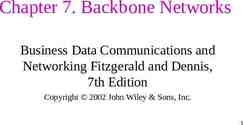CONTINUOUS QUALITY IMPROVEMENT FOR MIECHV AWARDEES: MODULE 7: CQI
22 Slides8.27 MB
CONTINUOUS QUALITY IMPROVEMENT FOR MIECHV AWARDEES: MODULE 7: CQI TOOLS II: ROOT CAUSE ANALYSIS TOOLS This document was prepared for the U.S. Department of Health and Human Services (HHS), HRSA, and ACF by James Bell Associates, Inc., under ACF contract number HHSP233201500133I. For more information, see http://www.jbassoc.com/reports-publications/dohve.
CQI Training Overview 1 2 3 4 5 6 7 8 9 Introduction to CQI Using Data to Drive CQI and Identify Topics Creating the CQI Culture and Forming a Team Creating SMART Aims Understanding the PDSA Process & Measurement CQI Tools I: Process Maps CQI Tools II: Root Cause Analysis Tools CQI Tools III: Key Driver Diagrams Reliability Concepts and Sustaining Gains
CQI Tools II: Root Cause Analysis Tools Learning Objectives Describe root cause analysis and three root cause analysis tools Apply systematic processes to identify root causes Analyze findings to determine where to focus CQI efforts
ROOT CAUSE ANALYSIS
What Is Root Cause Analysis? Systematic process Identifies causes associated with a problem of interest Detects why causes are present
Why Root Cause Analysis? Reduces inefficiencies Change strategies are targeted and more likely to be successful
ROOT CAUSE ANALYSIS TOOLS
5 Whys Problem: Happy Healthy Babies is experiencing staff turnover at a rate of 40% over an 18-month period. 1. Why is the rate of staff turnover high? 2. Why are staff applying for other jobs? 3. Why do other jobs provide more compensation than home visiting?
5 Whys 1. Why is the rate of staff turnover high? 2. Why are staff applying for other jobs? 3. Why do other jobs provide more compensation than home visiting? 4. Why is there a discrepancy between pay and job expectations? 5. Why does home visiting have more expectations and offer less support?
5 Whys Activity Step 1: Identify the problem Step 2: Ask the first why question Step 3: Walk the process backward, asking the next why question Step 4: Continue until arriving at the root cause 5 WH YS Id Ide en nttiiffy y th the u ep prro un nti ob till a ble lem arrri vin m in riv in th ing p the ga ro e fi prob att th stt b firrs the ble lem e ro bo m. roo ox ott c xb be us ca elo au low e. U w. In se In th Us em se the ult en mu ltip ne ex xtt b iple bo le w ox, wo x, a ork an rks ns sw sh we he ets ee err w hy if m ts if wh y th mo this ore is p re th ob prro tha n fi an ble ve lem fiv mo ew oc wh cc cu hy urr ys rre sa ed are d. C re n Co nttin ne ed on ee de inu ed ue d to e ask g to id ide nti ing w en fy the askin hy tify wh y the c ca au us se eo off tth he e WHA T PROB IS THE L EM ?
5 Whys Activity Debrief
Brainstorming
Fishbone Diagram
Fishbone Diagram
Fishbone Diagram Procedures People Home visitors lack training Mothers are hesitant to be screened There is currently no formal screening procedure Home visitors are reluctant to ask about sensitive topics Mothers are not screened for intimate partner violence (IPV) Screening tool is not valid The community lacks IPV services Data system’s auto-scoring function does not work Screening tool is cost prohibitive Environment Materials Reporting
Fishbone Diagram Activity Step 1: Identify the problem Step 2: Identify the main categories Step 3: Identify root causes Step 4: Analyze FISHBON E DIAGR AM A A fis fishb hbon one e diagra —also Is hiika kawa or diagram m—also known Ish wa or ca know as an caus pro use ov e an and effec agn as an pr es a viid des a vi su all depidcteffectt di di ram vis ua po tential ca depictio ion of thagram— — pote ntial caus n of es e us for know the Th a known This lps detees for a is he problem help n s ct pr d oblem. ar et gr s w test vari ect area ith ea grea s eate th w e ith the st varia ab biililitty im y an ovemen and portunity impr d op prov oppo ement. rtunity fo t. forr Us e the fish Use the fishb bo ne di on ag ide e diagra ram nttif ify o id ut en po lin m te e ou y potent ntial root to tline to pr ial root ca blle em pro ob causes for a m of of in st. The uses fo inte ra tere aid rest ai d in in th four this ocess. . The fo ps will ur ste is pr step proc s will ess. 1. Stat 1. St ate e th the prob m an at the hee proble lem and d in incl clud at the hea ad ude e it do it off th dia the e fis gr fishb am e diagra hbon one m . 2. 2. Id Iden y entif m ain tify mai categorie n ca co that bute to th tegories cont ntri ribu te to e pr les that th categorithe prob oblem thes Usin ese sing m. U e ca tegories g be th es,, la ll th la e be the h. e fis th fish. of e rib ribs s of 3. 3. U Use se th br ai the ns e torming brainsto w hy rm o e 5 s te wh ys tech que to iding orr th th chni niqu causes. Pl e to identify e 5 ca uses. Plac the causentify ace e th lin e es causes lines co nn th es on ec on co te nn d 4. Anal ected to th rib the e 4. Analyz e ribs. the causto the yze s. e th e cause s an de d es an dete d term e rmin w hich ones ine whi in ch ve to on es to invest stig igat ate e fu furt rthe focu herr or where to cus the ne or w fo here to s the next xt PD PDSA cle. SA cy cycle .
Fishbone Diagram Activity Debrief Prior to completing the fishbone diagram, what were teams’ assumptions concerning the root cause for the stated problem? How did assumptions change after completing the diagram? How did teams identify the root cause(s) on which to focus? How might teams use this process in future CQI work?
Remember. 1. 2. Root cause analysis helps CQI teams identify factors that lead to problems. 5 Whys, Brainstorming, Fishbone Diagram can be used to complete a root cause analysis.
Additional CQI Resources CQI Briefs: http://www.jbassoc.com/reports-publications/dohve Quality Improvement Toolbox: http://www.hrsa.gov/quality/toolbox/methodology/qualityimpr ovement/index.html
Disclaimer The purpose of the Design Options for Home Visiting Evaluation (DOHVE) is to provide research and evaluation support for the Maternal, Infant, and Early Childhood Home Visiting (MIECHV) Program. The project is funded by the Administration for Children and Families (ACF) in collaboration with the Health Resources and Services Administration (HRSA) under contract number HHSP233201500133I. This publication was developed by James Bell Associates on behalf of the U.S. Department of Health and Human Services (HHS), HRSA, and ACF. Its contents are the sole responsibility of the authors and do not necessarily represent the official views of HHS, HRSA, or ACF.



























